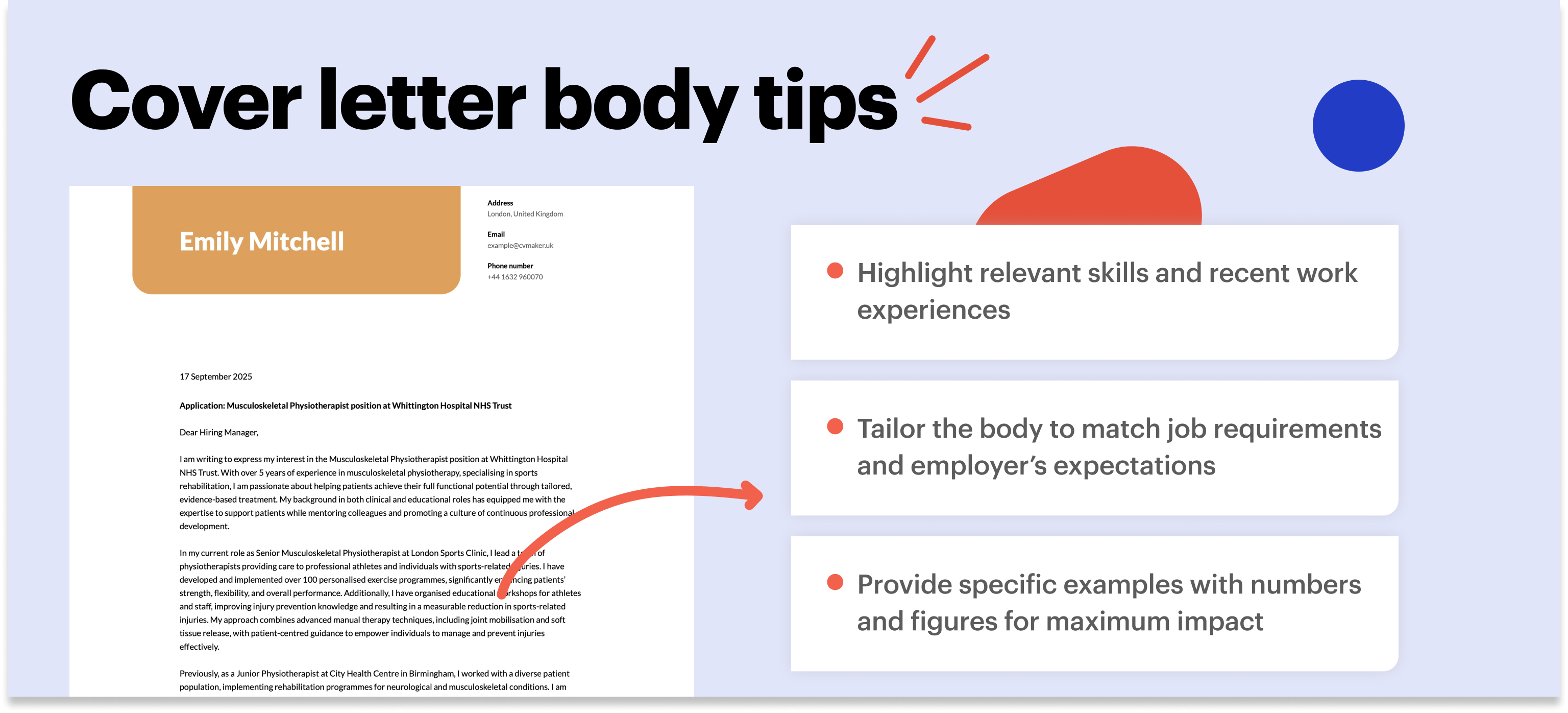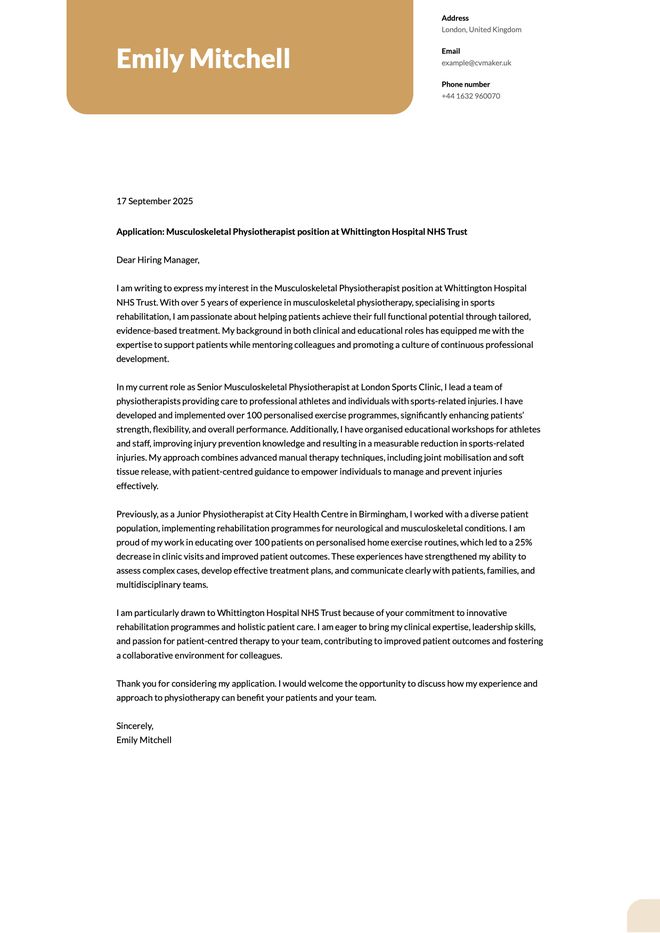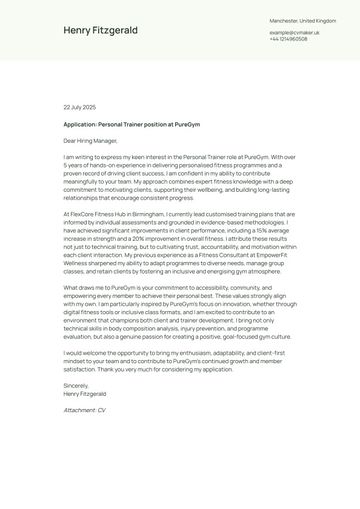
How to Write a Physiotherapist Cover Letter: With Examples, Tips and Templates
Creating a good CV is the first step in landing a physiotherapy role, but it’s your cover letter that really helps you flex your strengths. Unlike your physiotherapist CV, which outlines your qualifications and clinical experience, your cover letter gives you room to show your personality, explain your passion for helping patients, and demonstrate why you’d be a strong addition to the healthcare team. Think of it as the bridge between your skills on paper and your ability to connect with people in practice.
Whether you’re stretching into your first physiotherapy position, applying as an assistant, or moving into a specialised area such as sports rehab, neurology, or paediatrics, this guide will walk you through how to structure a cover letter that supports your application and strengthens your chances of success.
In this article, we cover:
Must-have sections for a physiotherapist cover letter
Physiotherapist cover letter samples and templates for different roles
Mistakes to avoid when writing your cover letter
Examples of cover letters for students, new graduates, and experienced professionals.

Physiotherapist cover letter example

Download this free UK physiotherapist cover letter example in PDF.
Why does this cover letter template work?
The Columbia template features a creative yet professional layout that clearly separates personal details from the main content.
It uses a modern, easy-to-read font and a prominent heading, giving the letter a polished, approachable look.
The structure emphasises patient care experience while keeping contact information and personal details clearly visible for quick reference.
How to format a cover letter for physiotherapist jobs
Your physiotherapist cover letter should flow as smoothly as a well-designed treatment plan: clear, purposeful, and tailored. The structure helps guide the reader through your professional details, clinical expertise, and motivation for applying, so that every part works together to support your application.
Pro tip
Keep your CV and cover letter in sync with a consistent, professional design. Make sure your style and tone reflect your professionalism and compassion. Tailor your content to each role, aligning your skills with the specific requirements of the job description.
Must-have cover letter sections
Personal details: Include your full name, contact information, and location.
Introduction: Start with a greeting, then provide a concise yet compelling introduction.
Body: Highlight pertinent expertise and abilities, incorporating noteworthy achievements if applicable.
Conclusion: Summarise everything into a brief paragraph, followed by a professional sign-off.
Learn more about how to write a good cover letter.
What to include in your physiotherapist cover letter
Header: Add your full name, location, phone number, and professional email address so you’re easy to reach.
Greeting: Whenever possible, address the hiring manager directly. If their name isn’t available, use a courteous option such as “Dear Hiring Manager.”
Introduction: Clearly state the physiotherapy role you’re applying for, while giving a snapshot of your background. You might mention your clinical placements, NHS experience, or areas of specialism such as musculoskeletal rehabilitation, neurology, or paediatrics.
Body: Spotlight key skills and achievements that align with the job description. Include both clinical expertise (e.g., patient assessment, manual therapy, exercise prescription) and soft skills (e.g., empathy, communication, and teamwork) that are essential in patient care.
Conclusion: Express genuine enthusiasm for the role, reaffirm your commitment to improving patient outcomes, and note your readiness to discuss your application further in an interview.
Sign-off: End with a professional closing such as “Sincerely” or “Kind regards,” followed by your full name. If you’re including attachments like your CV or references, mention them beneath your signature.
How to write a good cover letter introduction for physiotherapist roles
Your cover letter introduction is where you set everything in motion. Much like the first session with a patient, it’s your chance to make a strong, confident start. The opening paragraph should quickly highlight your professional background, core skills, and enthusiasm for the physiotherapy role.


Recommended things to include in your cover letter introduction:
The exact role you’re applying for.
Your current or most recent job title.
Relevant qualifications.
Areas of experience (e.g., musculoskeletal, neurological, sports rehabilitation, paediatrics)
Knowledge of patient care techniques, exercise prescription, and evidence-based practice.
Physiotherapist cover letter introduction examples
Physiotherapist assistant cover letter introduction example
I am writing to express my interest in the Physiotherapist Assistant role at Norfolk & Norwich University Hospitals. With hands-on experience supporting MSK rehabilitation sessions, strong communication skills, and a commitment to patient-centred care, I am excited about the opportunity to assist your physiotherapists to deliver high-quality treatment across clinics and inpatient wards in Norwich.
Physiotherapy intern cover letter introduction example
As a final-year BSc Physiotherapy student at the University of Medical Centre, I am thrilled to apply for the Intern Physiotherapist position at UCLH. My clinical placements in orthopaedics and acute care, along with my HCPC registration in progress, have prepared me for providing evidence-based treatment, and I am eager to learn further while contributing to your team’s renowned excellence in patient rehabilitation.
Senior physiotherapist cover letter introduction example
Having served as a Band 6/7 MSK Physiotherapist for over eight years, I was excited to see the Senior Physiotherapist opening at Norfolk & Norwich and Great Yarmouth & Waveney NHS Trust (NCH&C). I bring extensive experience leading outpatient and community teams, overseeing complex case management, and mentoring junior staff, and I am eager to help enhance your service delivery and patient outcomes across Norfolk.
Children's physiotherapist cover letter introduction example
I am delighted to apply for the Children’s Physiotherapist position at Great Ormond Street Hospital. Having worked with paediatric patients during my rotations, specialising in developmental delay and neurological conditions, I am passionate about creating family-centred therapy plans that build confidence, motor function, and independence in young children under expert supervision.
Sports physiotherapist cover letter introduction example
I am writing to express my keen interest in the Sports Physiotherapist position at the Tottenham Hotspur Academy. With two years of experience working in elite youth sport, managing injury prevention and performance rehabilitation, I bring expertise in load management, pitch-side care, and gym-based rehab, and I am committed to helping academy-athletes return stronger, faster, and ready to perform.
How to write a cover letter body for a physiotherapist role
Write 1-3 clear paragraphs in this section to highlight your strengths, clinical expertise, approach to patient care, and dedication to improving outcomes. This is your chance to connect your professional experience directly to the employer’s services and values, showing that you not only have the skills but also share their patient-centred mission.

Pro tip
Mention specific achievements or projects, such as: “Designed and implemented a post-operative rehabilitation programme that reduced recovery times for orthopaedic patients by 20%”.
Tips for a good physiotherapist cover letter body:
Mention projects:
Developing tailored rehabilitation programmes for MSK or neurological patients
Leading group physiotherapy or hydrotherapy sessions
Supporting early mobilisation and discharge planning
Delivering sports injury prevention and recovery programmes
Contributing to community or paediatric physiotherapy outreach initiatives.
Describe your duties:
Assessing patients and creating evidence-based treatment plans
Using manual therapy, exercise prescription, and electrotherapy techniques
Collaborating with multidisciplinary teams (doctors, OTs, nurses)
Educating patients and families on at-home exercise and recovery routines
Documenting progress accurately and maintaining HCPC-compliant records
Supervising or mentoring junior physiotherapists, students, or assistants.

How to tailor your cover letter body for specific roles:
For physiotherapy assistants: Emphasise patient support, helping deliver exercise programmes, and excellent communication skills.
For paediatric physiotherapists: Emphasise child-centred therapy, working closely with families, and adapting treatment into playful sessions.
For sports physiotherapists: Showcase experience with injury prevention, rehabilitation, and return-to-play programmes.
Physiotherapist cover letter body paragraph examples
Physiotherapist assistant cover letter body example
In my previous role as a Healthcare Assistant at Addenbrooke’s Hospital, I regularly supported physiotherapists in delivering patient rehabilitation exercises and mobility programmes. I ensured patients felt comfortable, encouraged adherence to prescribed routines, and recorded progress accurately. This experience has strengthened my ability to combine empathy with practical support, which I believe will allow me to provide excellent assistance to your physiotherapy team.
Physiotherapy intern cover letter body example
During my clinical placement at University College London Hospitals (UCLH), I worked across musculoskeletal and acute care wards, assisting in patient assessments, exercise prescription, and manual therapy under supervision. I became confident in engaging patients of different backgrounds and ensuring treatment plans were followed safely and effectively. These experiences have given me a solid foundation in evidence-based practice, and I am eager to continue developing my skills as part of your physiotherapy team.
Senior physiotherapist cover letter body example
In my current role as a Band 6 MSK Physiotherapist at Guy’s and St Thomas’ NHS Foundation Trust, I lead a caseload of complex musculoskeletal patients while also mentoring junior staff and student physiotherapists. I have successfully introduced a new exercise-based rehabilitation pathway that reduced waiting times by 18% and improved patient-reported outcomes. I am passionate about clinical leadership and service improvement, and I am keen to bring this expertise to support both patients and colleagues at your trust.
Children's physiotherapist cover letter body example
My experience at Great Ormond Street Hospital has allowed me to specialise in working with children with cerebral palsy and developmental delays. I pride myself on creating fun, engaging, and family-centred physiotherapy programmes that encourage active participation from both children and parents. By adapting therapy into playful activities, I have seen improvements not only in physical mobility but also in children’s confidence and independence.
Sports physiotherapist cover letter body example
As a Sports Physiotherapist with Fulham FC Academy, I have worked closely with coaches and medical staff to design rehabilitation and injury-prevention programmes tailored to young athletes. I specialise in return-to-play protocols, strength and conditioning integration, and pitch-side injury management. My ability to combine clinical expertise with a performance-focused approach has helped reduce recurring injuries among academy players and supported their progression to higher levels of competition.

How to end a cover letter for physiotherapist jobs
In your cover letter conclusion, reaffirm your passion for physiotherapy, emphasise your readiness to contribute to patient care and the wider team, and thank the employer for considering your application. Keep it professional yet warm, leaving the impression that you are motivated, reliable, and enthusiastic about the role.

Physiotherapist cover letter conclusion examples
Physiotherapist assistant cover letter conclusion example
I would welcome the opportunity to bring my enthusiasm and patient-focused approach to the physiotherapy team at Norfolk & Norwich University Hospitals. Thank you for considering my application, and I look forward to the chance to discuss how I can support your physiotherapists in delivering high-quality care across wards and outpatient clinics.
Physiotherapy intern cover letter conclusion example
I am eager to continue developing my clinical skills while contributing to the outstanding patient care at UCLH. Thank you for taking the time to review my application, and I would be delighted to discuss how my training and enthusiasm can support your physiotherapy department.
Senior physiotherapist cover letter conclusion example
I am excited about the opportunity to apply my leadership experience and advanced clinical expertise to strengthen services at Norfolk & Norwich and Great Yarmouth & Waveney NHS Trust (NCH&C). Thank you for your consideration, and I would welcome the opportunity to discuss how I can contribute to both patient outcomes and team development in greater detail.
Children's physiotherapist cover letter conclusion example
I am passionate about helping children achieve their full potential and would be honoured to bring my skills and experience to the paediatric physiotherapy service at Great Ormond Street Hospital. Thank you for considering my application, and I would be delighted to discuss how I can support your team in delivering exceptional care to young patients and their families.
Sports physiotherapist cover letter conclusion example
I am enthusiastic about the prospect of contributing my sports rehabilitation expertise to Tottenham Hotspur FC Academy and supporting athletes in reaching peak performance. Thank you for reviewing my application, and I would welcome the chance to discuss how my skills and experience can add value to your medical and performance team.
How to write a physiotherapist cover letter with no experience
Not having direct physiotherapy experience doesn’t mean you can’t apply. Employers highly value enthusiasm, transferable skills, and a willingness to learn and grow within the profession.
Tips for writing a physiotherapy cover letter with no experience:
Highlight transferable skills: communication, teamwork, empathy, reliability, and problem-solving
Show passion for physiotherapy: mention relevant coursework, clinical placements or volunteering
Emphasise willingness to learn: demonstrate commitment to following evidence-based practice, safety protocols, and HCPC standards
Align with employer’s mission: show understanding of the clinic or hospital’s values, like patient-centred care.
Physiotherapist cover letter example without experience

Download this free UK physiotherapist cover letter for non-experienced professionals in PDF.
Keywords for a physiotherapist cover letter
Including healthcare and physiotherapy-specific terms in your cover letter can make a big difference for both employers and applicant tracking systems (ATS). Using targeted keywords that reflect the job description shows that you understand the role, have relevant skills, and have tailored your application thoughtfully. This approach helps you stand out and demonstrates professionalism and attention to detail.
Industry terms you can include
5 common mistakes to avoid when writing a physiotherapist cover letter
When writing your cover letter, avoiding common pitfalls is key to ensuring your application is taken seriously and makes a strong impression.
1. Overloading with medical jargon
“I have experience developing personalised exercise programmes for patients recovering from orthopaedic surgery.”
“I am proficient in proprioceptive neuromuscular facilitation, kinesiological taping, and myofascial release techniques across multiple pathophysiological conditions.”
Pro tip
Keep language clear and accessible for recruiters who may not be physiotherapy specialists.
2. Ignoring the employer’s values
“I am drawn to Great Ormond Street Hospital’s family-centred care approach and am committed to supporting children’s physical development in a compassionate environment.”
“I am applying because my dream is to work in paediatric physiotherapy in London.”
Pro tip
Demonstrate understanding of the employer’s mission or patient focus.
3. Failing to quantify impact
“Introduced a mobility programme that reduced average patient recovery time by two weeks.”
“I helped patients get better faster.”
Pro tip
Specific metrics or outcomes make your contributions concrete and memorable.
4. Repeating your CV
“My clinical placements allowed me to practise patient assessment, but I also developed strong communication skills, ensuring patients understood their treatment plans.”
“I have worked in Chiswick Nursing Centre and completed assessments and treatments.”
Pro tip
Use your cover letter to add context, insights, or examples beyond the CV.
5. Being too generic about your role
“I collaborated closely with multidisciplinary teams to tailor rehabilitation plans, ensuring each patient’s needs were addressed effectively.”
“I worked with patients and teams at the hospital.”
Pro tip
Be specific about your responsibilities and contributions, showing how you added value rather than just stating general tasks.
Physiotherapy cover letter essentials
Tailor each cover letter to the specific role and employer, highlighting relevant skills, experiences, and alignment with their mission.
Use a strong introduction to immediately convey your enthusiasm, qualifications, and suitability for the position.
The body should showcase clinical expertise, achievements, and transferable skills, providing concrete examples of your impact.
Conclude professionally by expressing your eagerness to contribute, reaffirming your value, and thanking the employer for their consideration.
Avoid common mistakes such as being too vague, overloading with technical terms, ignoring achievements, and neglecting to show understanding of the employer or patient population.
Next steps?
Pair your physiotherapist CV with a tailored cover letter to demonstrate to employers that you’re qualified, enthusiastic, and ready to contribute to patient care. You can use our AI-powered cover letter builder with custom templates to simplify the process. Need help refining your professional documents? Try our CV and Cover Letter Writing Service for expert guidance in creating polished applications. For more insights, explore our blog articles on the average salary in the UK, how to prepare for job interviews with AI, and what not to say in interviews to get shortlisted to the next stage.
FAQs
Can a foreign physiotherapist work in the UK?
Yes, foreign-trained physiotherapists can work in the UK. To practice, you must:
Register with the Health and Care Professions Council (HCPC): This is mandatory for all physiotherapists in the UK.
Apply for a visa: Most non-EU nationals will need a Health and Care Worker visa, which requires a job offer from a licensed sponsor and a certificate of sponsorship.
For more insights, explore our article on job opportunities for international students in the UK.
What is the 80/20 rule in physiotherapy?
In physiotherapy, the 80/20 rule suggests that:
20% of the treatment time focuses on reducing pain and inflammation.
80% is dedicated to rehabilitating and strengthening the surrounding muscles to prevent future issues.
This approach emphasises long-term recovery over short-term relief.
How much do physios get paid in the UK?
According to Glassdoor, the average annual salary for a physiotherapist in the United Kingdom is £37,725, typically ranging between £32,000 and £44,000. Earnings vary based on experience and area of specialisation. For instance, newly qualified physiotherapists in the NHS usually begin at Band 5, while more experienced or specialist roles progress to Band 6 and Band 7, offering higher pay with increased responsibility.
Explore our article on the highest-paying jobs in the UK.
Are physios in demand in the UK?
The demand for physiotherapists in the UK is exceptionally high, driven by several key factors:
NHS workforce shortages: The NHS is experiencing a critical shortage of physiotherapists, resulting in longer waiting times for treatments and services.
An ageing population: With an increasingly older population, there is a growing need for physiotherapy to address age-related conditions and maintain quality of life.
Rising musculoskeletal issues: With musculoskeletal disorders rising, the demand for proficient physiotherapists to deliver essential care and rehabilitation is greater than ever.
For more inspiration, check out our article on in-demand jobs in the UK.







)

)